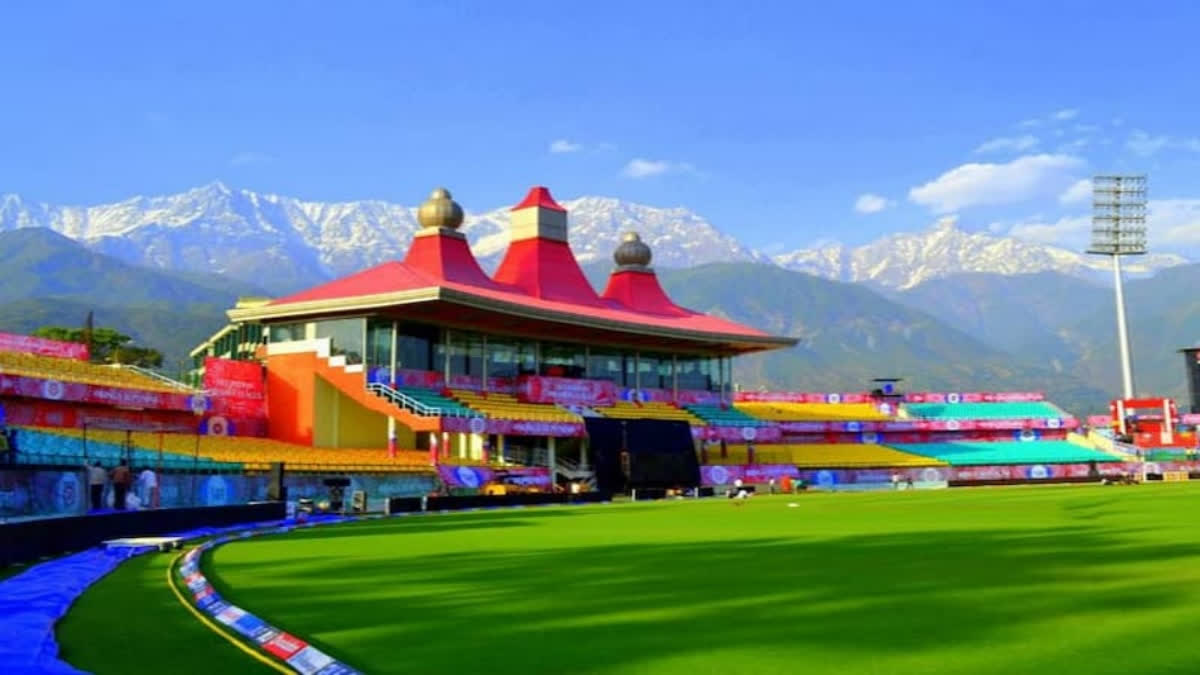Dharamshala: Standing just outside the green winter grass ring of the Dharamshala Cricket Stadium’s lush outfield, dwarfed by the towering Dhaula Dhar peaks dressed in fresh whites, one wonders how a sloping hill with a rivulet cutting across it could have been turned into this picturesque cricketing marvel.
Indeed, a lot of work went into engineering this facility and making it into a quaint cricket field atop a hill. First the slope was sliced off to shape a circular plateau and then the rivulet was redirected to the other end where it now gurgles down undisturbed.
The ground, with a capacity of 21,800 seats which have, this season, been coloured in ICC hues to honour the World Cup, on one end looks down at a deep valley and, on the other, looks up to pay obeisance to the syrupy mountain peaks.
There are grounds and grounds which romance the hills in various parts of the world, but the Dharamshala stadium singularly enjoys a Himalayan reputation, taller than the 1457 meters it sits atop.
It is the highest cricket stadium in the world and the only cricket ground in the world where the Dalai Lama once sat and saw an entire match and it is the only facility in India where rye grass, a winter grass that refuses to die even in sub zero winters, adds to the hue of the lush green outfield.
Dharamshala, the winter Capital of Himachal Pradesh and the spiritual seat of the Dalai Lama, won the competition to get this stadium against a mightier, trendier and much higher altitude Shimla simply because it had one thing Himachal’s summer capital craves for – space, any inch of it that it is now unable to find.
“We had the space, but it was the vision of Mr Anurag Thakur who could envisage this sloping piece of land going down the hill with a rivulet running through, it as a stadium, the beautiful facility that it is today,” the Himachal Pradesh Cricket Association’s executive member Mohit Sud says, pointing at the unique Himachali temple architecture encasing the stadium at the two ends.
Standing and watching the sun playing hide and seek with the clouds merging with the snowcapped sentinels of Dharamsala, you tend to compare it with the more serenaded Newlands Cricket Ground in South Africa’s Cape Town. That one too is majestic with the Table Mountain running across one side as also the Devil’s Peak.
What it lacks though is the heartwarming pithiness of Dharamsala where the town and the ground as both petite and alluring. Pedigree also fights for the Saxton Oval at Nelson in New Zealand which is younger and smaller but equally mesmerising. With just a 6,000 capacity and mountains swooning over the stands, it happens to your senses not just for cricket!
Dharamshala got five World Cup matches to host for the first time ever this time, though Sud differs to point out that the ground has earlier hosted the T2O World Cup matches. Then, too, the outfield was scratchy but safe for players to dive around.
“Earlier. we had Bermuda grass, but we recently shifted to rye,” Sud tells you. The charming stadium belies the detailed work that has gone into it ever since it started holding international matches. Under the ground there lies a detailed sub-air evacuation process and laser-assisted pipes which can soak water quickly. They can dry off the town and its stadium in 10 minutes despite Dharamshala being the second wettest town in the country which has been a victim of crippling rain volume.
Also, it has a brave stretch in the middle giving currency to seamers and spinners. The wicket here traditionally hard and sometimes has the audacity to splash some grass. “Despite the prolonged winter, heavy rains and too much moisture, the grass in the outfield is robust and green,” Sud points out to a spot where he sees some patch works of grass and soil. “Yes, it is a scratchy outfield but not dangerous for fielders,” he adds.
The stadium got going in 2005 but it was eight years later that it got to host its first international match. Thereon, there has been no looking back for this pleasantly old-fashioned ground doting on LED lights that are three times more powerful than the regular ones, a colourful facade lighting up the stadium, led lighted pathways, 26 modern toilets and a Press box that is vertically aligned with the pitch with a capacity of 125 plus a 25-capacity spillover.
The reason why a knockout round match was not given to the DCS, lies not in its newness but in its inherent lack of big sport infrastructure. “As compared to other big town stadium, the infrastructure here is not wholesome enough. The town is small, hotels are limited, and flights get sold out quicker than the dew falling on the outfield on a wintery night.
That brings one to the unique hill ground issue of moth swarms in the night, bothering the game in the middle. Special fumigation, Sud assures, has been done to reduce it to a negligible degree. Also the non-toxic farm sprays have been dealing with the night dew falls.
The highest total recorded here has been 364/9 between England and Bangladesh, while the lowest has been 112/10 (38.2 overs) by India vs Sri Lanka. Figures and statistics aside, this one is for the senses, and a good game of cricket tomorrow!


